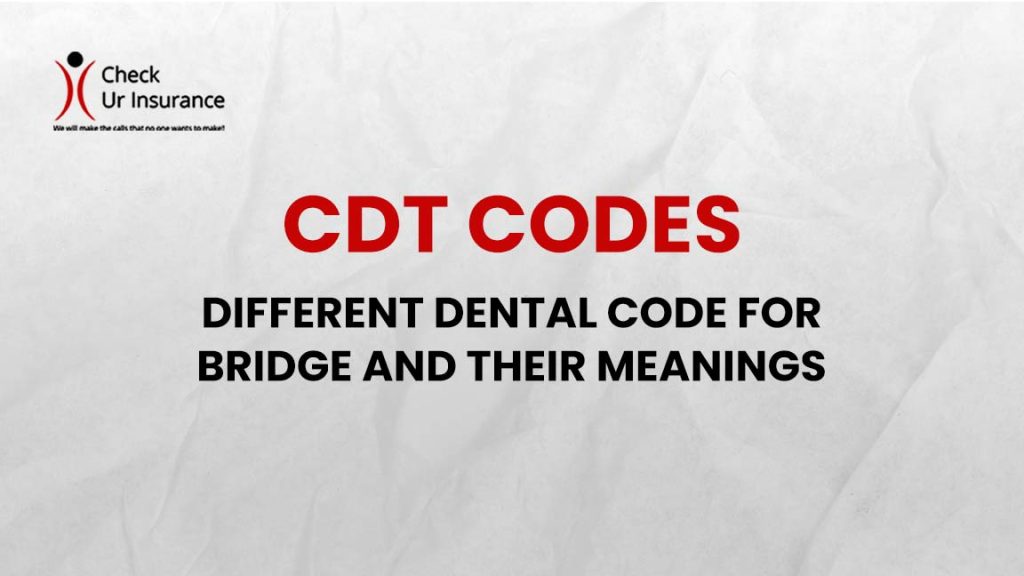Different CDT Dental Code for Bridge and their meanings
A personalized dental restoration, a dental bridge, relies on the support of adjacent teeth for stability. These bridges, crafted meticulously using various materials such as metal, ceramics, or a skillful combination, cater to the specific needs of each patient. Your trusted dentist will provide detailed guidance on the most suitable dental code for bridge based on your unique oral situation.
Let’s delve deeper into some of the essential bridges dental code commonly associated with the creation of these bridges:
Table of Contents
Bridges Dental Code
D6740: Retainer Crown – Porcelain/Ceramic
First Dental Code for Bridge is D6740, this particular dental procedure code represents the fabrication of a prosthetic crown crafted from either porcelain or ceramic. These materials are preferred for their natural aesthetics and durability, ensuring a seamless integration into your dental structure.
D6791: Retainer Crown – Full Cast, Predominantly Base Metal
In cases where a crown predominantly constructed from base metal is required to cover the entire remaining portion of the tooth, dental professionals employ the D6791 procedure code. This robust and resilient option provides comprehensive tooth protection.
D6790: Retainer Crown – Full Cast High Noble Metal
High noble metals shine in the dental world, and the D6790 code is employed when crafting a prosthetic crown made of these exceptional materials. With their superior biocompatibility and strength, high noble metal crowns ensure the longevity of your dental work.
D6245: Pontic – Porcelain/Ceramic
The D6245 CDT code pertains to ceramic or porcelain prosthetic crowns, often used to replace missing teeth within a fixed partial denture. These crowns not only restore your smile but also maintain a natural look and feel.
D6240: Pontic, Porcelain Fused to Precious/High Noble Metal
This code indicates the fusion of porcelain to high noble metal in creating the pontic. High noble metals are known for their biocompatibility and strength.
D6241: Pontic, Porcelain Fused to Predominantly Base Metal/Non-Precious Metal
When predominantly base metals are used in combination with porcelain for the pontic, this code comes into play, offering durability and cost-effectiveness.
D6242: Pontic, Porcelain Fused to Semi-Precious/Noble Metal
Semi-precious and noble metals provide a balance between strength and affordability when used in conjunction with porcelain for the pontic.
D6750: Crown, Porcelain Fused to Precious/High Noble Metal
When crafting crown units for bridges, this code signifies the use of precious or high noble metals, which are known for their durability and biocompatibility.
D6751: Crown, Porcelain Fused to Predominantly Base Metal/Non-Precious Metal
Utilizing predominantly base metals alongside porcelain in crown fabrication, this code provides a cost-effective option.
D6752: Crown, Porcelain Fused to Semi-Precious/Noble Metal
Semi-precious and noble metals paired with porcelain for crown units offer a balance between strength and affordability.
D6210: Pontic for Maryland Bridge, Cast Metal, Precious/High Noble Metal
In the creation of Maryland bridges, this code indicates the use of cast metal, especially precious or high noble metals for pontic construction.
D6545: Wing Retainer, Cast Metal for Bonded Fixed Prosthesis
When a cast metal wing retainer is used in bonded fixed prostheses, this code comes into play.
D6548: Wing Retainer, Porcelain/Ceramic for Bonded Fixed Prosthesis
The use of porcelain or ceramic wing retainers in bonded fixed prostheses is signified by this code.
D6549: Wing Retainer, Composite or Resin
The last Dental Code for Bridge on our list is D6549, For bonded fixed prostheses incorporating composite or resin wing retainers, this code is applied.
In summary, the world of dental bridges offers a range of options to restore your smile and oral health. Your dentist will carefully assess your needs and recommend the most suitable materials and procedures to ensure your dental bridge is a perfect fit for you. Hope this blog helped you if it did you can visit our BLOG page and read more informative article/blogs, Have a great one!
Did you like this article? Read more helpful latest blogs

